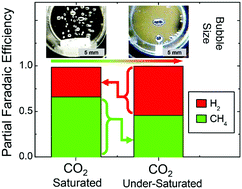Effects of temperature and gas–liquid mass transfer on the operation of small electrochemical cells for the quantitative evaluation of CO2 reduction electrocatalysts†
Abstract
In the last few years, there has been increased interest in electrochemical CO2 reduction (CO2R). Many experimental studies employ a membrane separated, electrochemical cell with a mini H-cell geometry to characterize CO2R catalysts in aqueous solution. This type of electrochemical cell is a mini-chemical reactor and it is important to monitor the reaction conditions within the reactor to ensure that they are constant throughout the study. We show that operating cells with high catalyst surface area to electrolyte volume ratios (S/V) at high current densities can have subtle consequences due to the complexity of the physical phenomena taking place on electrode surfaces during CO2R, particularly as they relate to the cell temperature and bulk electrolyte CO2 concentration. Both effects were evaluated quantitatively in high S/V cells using Cu electrodes and a bicarbonate buffer electrolyte. Electrolyte temperature is a function of the current/total voltage passed through the cell and the cell geometry. Even at a very high current density, 20 mA cm−2, the temperature increase was less than 4 °C and a decrease of <10% in the dissolved CO2 concentration is predicted. In contrast, limits on the CO2 gas–liquid mass transfer into the cells produce much larger effects. By using the pH in the cell to measure the CO2 concentration, significant undersaturation of CO2 is observed in the bulk electrolyte, even at more modest current densities of 10 mA cm−2. Undersaturation of CO2 produces large changes in the faradaic efficiency observed on Cu electrodes, with H2 production becoming increasingly favored. We show that the size of the CO2 bubbles being introduced into the cell is critical for maintaining the equilibrium CO2 concentration in the electrolyte, and we have designed a high S/V cell that is able to maintain the near-equilibrium CO2 concentration at current densities up to 15 mA cm−2.



 Please wait while we load your content...
Please wait while we load your content...